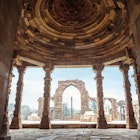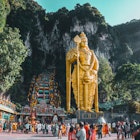For the professional photographer, landscape photography demands a very different way of working. Typically photographed with the camera mounted on a tripod, the aperture is given priority to ensure the image is sharp from front to back. As for light, the window of opportunity is small, limited to the beginning and end of the day. Simply by putting the camera on a tripod, the technical and compositional process becomes more considered, so there really is no excuse (except for not having the appropriate lens) for not using every pixel available to capture the subject and getting the exposure right.
Choose your moment
Don’t be fooled into thinking that just because landscapes don’t walk off like people do, it’s any less demanding. As with all subjects, the high point, when all the elements come together perfectly, is usually fleeting. You need to be ready and waiting for that moment. While you’re waiting, experiment with various compositions and settle on the best one so you’re not decision-making when you should be making exposures.
Isolate elements of the scene
When we look at a scene we scan a wide area, noting the colour, beauty, scale and main features - we see straight through power lines and rubbish bins and create in our mind’s eye a perfect impression of the scene. The camera sees everything; it doesn’t know you didn’t mean to include the toilet block on the left or the ‘Keep Out’ sign on the right. When you are confronted with a beautiful scene it’s very tempting to put on the widest lens to try and get everything into your composition. Remember that landscapes don’t have to always take in the big scene. Isolate elements that say something about the environment and complement the panoramic views. As with all good compositions, there needs to be a point of interest in the landscape, a main feature that can hold the viewer’s attention. Choice of an appropriate lens plays a major part in achieving this.
Wide-angle lenses increase the foreground and sky content, exaggerate sweeping lines and make the subjects in a landscape smaller. Make sure that the foreground and sky are interesting and relevant to the composition. Telephoto lenses allow you to select a part of a scene and to flatten the perspective, making the foreground and background elements appear closer to each other. What you focus on will become larger.
Stay focused
Generally, the aperture is given priority when shooting landscapes, to ensure sharpness from front to back. For maximum depth of field, focus on a point one-third into the scene, just beyond the foreground subject, and stop down to f16. Use the depth-of-field button to confirm visually what you’re hoping to achieve. At this aperture, with a sensor setting of ISO 100, shutter speeds will drop below 1/15. A tripod and cable release are essential equipment for the serious landscape photographer.
On windy days slow shutter speeds will record movement in the landscape. Swaying branches will blur at 1/15 or slower, depending on how strong the wind is. This can be very effective if desired. Clouds may also blur if exposures are longer than half a second, which isn’t so effective. As you compose landscapes pay particular attention to the horizon and check the elements in the frame.
- Place horizons carefully. Start with the rule of thirds to ensure the horizon is placed away from the middle of the frame. If the sky is dull and lacking detail it will look flat. Place the horizon in the top third of the frame. If the foreground is uninteresting place the horizon on the bottom third. If both do nothing for the photograph, eliminate them by moving closer or zooming in.
- Horizons should be straight.
- Scan your viewfinder before you release the shutter to check for unwanted elements, particularly at the edges of the frame.
- Don’t accidentally photograph your shadow in the landscape. You have to be especially careful when shooting very early or very late in the day with wide-angle lenses. Shoot from a low angle or position your shadow in a natural shadow area of the composition.
- Professional landscape photographers habitually rise early for first light and return two or three hours before sunset to make the most of the warm, low-angle light. This light is available to everyone. You don’t need expensive equipment to get up early…just a good alarm clock and a lot of will power.
Ready to take your pictures to the next level? Pick up a copy of Lonely Planet's Guide to Travel Photography.












